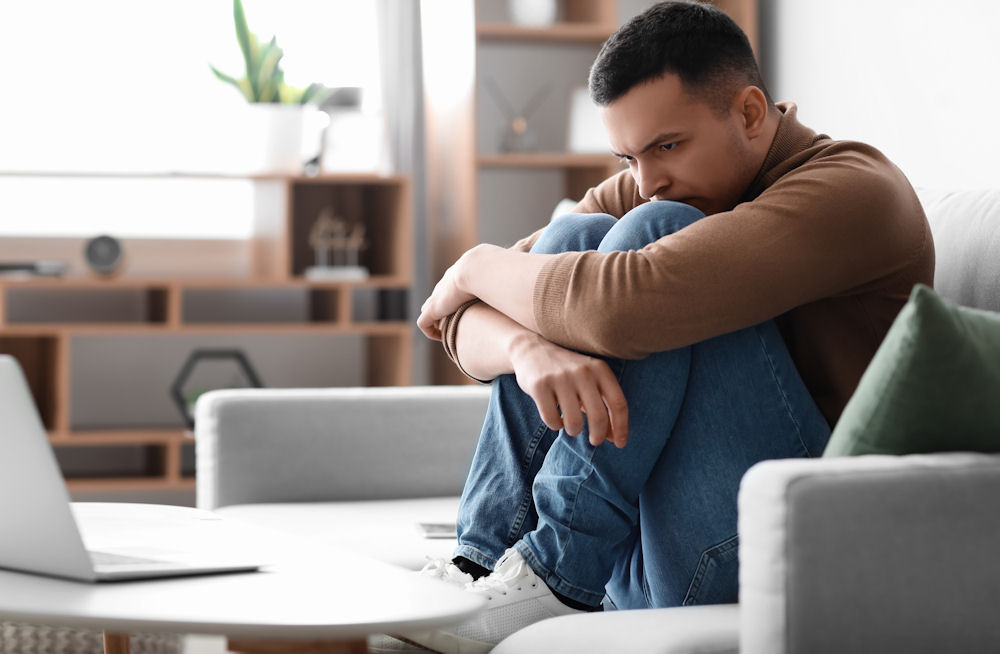Anxiety in men is a topic that often does not get enough attention. Many men experience anxiety, but the signs can be overlooked or misunderstood. Discovery Institute recognizes that anxiety in men may look different and can bring unique challenges, especially when there are other issues like substance use.
This article explains what anxiety disorders are, how they affect men, and why understanding these differences is important. It also looks at how common anxiety in men is and the link between anxiety and addiction, as well as other mental health conditions.
Understanding Anxiety in Men
Anxiety disorders are mental health conditions marked by ongoing feelings of fear, worry, or nervousness that disrupt daily life. For men, these feelings might show up as irritability, anger, or physical symptoms such as headaches or muscle tension, rather than open expressions of fear or worry.
Men often experience anxiety differently from women. While both can feel anxious, men may be less likely to talk about their feelings or seek help. Societal expectations sometimes encourage men to hide their emotional struggles, so their anxiety may go unnoticed by others and themselves.
Recent statistics from the National Institutes of Health show that about 14% of men in the United States have an anxiety disorder each year. This means millions of men are affected annually, even though many do not get diagnosed or treated. Key differences in male anxiety symptoms:
- Physical symptoms: Headaches, muscle tension, and stomach problems are more common
- Emotional expression: Irritability and anger instead of obvious worry or fear
- Help-seeking behavior: Less likely to discuss symptoms or seek professional support
How Common Is Anxiety Disorder in Men
This difference in diagnosis rates may reflect actual differences in prevalence, but it also points to underreporting among men. Many men do not discuss their symptoms or seek professional help, often due to stigma or cultural expectations that discourage emotional vulnerability.
Young adult and middle-aged men show the highest rates of reported anxiety symptoms. However, the actual number of affected individuals may be higher due to underrecognition and reluctance to seek support in these age groups.
Signs and Symptoms of Male Anxiety
Anxiety symptoms in men can differ from typical descriptions found in medical literature. Recognizing these patterns helps identify anxiety even when it appears in unexpected ways.
Men with anxiety disorders often notice physical symptoms first. These can include a racing heart, chest pain, or heart palpitations that may be mistaken for heart problems. Digestive issues like nausea, stomach pain, or changes in appetite are also common.
Sleep disturbances frequently occur, including trouble falling asleep, staying asleep, or feeling restless at night. Other physical signs include persistent headaches, muscle tension throughout the body, and ongoing fatigue that doesn’t improve with rest.
Male anxiety symptoms often appear as irritability or anger rather than obvious worry. Some men experience emotional numbness, making it difficult to recognize or express feelings. Concentration problems can develop, including racing thoughts or difficulty focusing on work tasks. Common behavioral changes include:
- Work patterns: Overworking, perfectionism, or sudden drops in productivity
- Social withdrawal: Avoiding social situations or responsibilities
- Substance use: Increased self-medicating with alcohol or drug use as a coping mechanism
- Relationship impacts: More frequent conflicts or emotional withdrawal from family and friends
Why Anxiety Looks Different in Men
Social and cultural factors shape how men experience and express anxiety. These influences don’t mean men feel less anxiety, but they affect how symptoms are recognized and addressed.
Societal Expectations and Masculinity Norms
Cultural norms often encourage men to appear strong and avoid showing vulnerability. Many boys grow up learning that expressing fear, sadness, or worry signals weakness. This societal pressure can lead men to hide their anxiety or avoid discussing it, even with trusted individuals.
Traditional masculinity emphasizes self-reliance and problem-solving over emotional expression. Men may focus on “fixing” their anxiety rather than exploring or sharing their feelings. This approach can delay recognition of symptoms and postpone seeking appropriate support. How masculinity affects anxiety expression:
- Emotional restriction: Difficulty recognizing and discussing feelings
- Physical manifestation: Emotional distress expressed through headaches, muscle tension, or stomach problems
- Professional concerns: Fear that showing anxiety could affect workplace reputation or advancement
Common Causes of Anxiety in Men
Anxiety in men develops from multiple factors working together. Understanding these causes helps explain why some men develop anxiety disorders while others do not.
Biological and Genetic Factors
Family history plays a significant role in anxiety development. Men with parents or siblings who have anxiety disorders face a higher risk of developing similar conditions. Brain chemistry imbalances involving neurotransmitters like serotonin and dopamine contribute to anxiety symptoms.
In New Jersey, medical conditions can trigger or worsen anxiety. Chronic illnesses, heart conditions, thyroid problems, and hormonal changes all influence anxiety levels. Some medications also list anxiety as a potential side effect.
Life Stresses and Environmental Factors
Work-related pressures create significant stress for many men. Job performance concerns, financial responsibilities, and career uncertainty contribute to ongoing anxiety. Major life changes like divorce, job loss, or health problems can trigger anxiety disorders. Common environmental triggers:
- Substance use: Alcohol, caffeine, and drugs can increase anxiety symptoms
- Sleep disruption: Irregular sleep patterns or chronic sleep deprivation
- Digital overload: Social media and information exposure
- Relationship conflicts: Family responsibilities and communication difficulties
Types of Anxiety Men Experience
Different anxiety disorders affect men in distinct ways. Understanding these differences helps with recognition and treatment planning.
Generalized anxiety disorder involves persistent, excessive worry about everyday concerns. In men, this often appears as muscle tension, irritability, and difficulty relaxing. Work-related anxiety and perfectionism are common features.
Men with generalized anxiety may overwork as a way to manage their worries, but this often increases stress levels. Sleep problems and relationship strain frequently develop as symptoms worsen over time.
Social anxiety in men often centers on work and professional situations. Men may avoid presentations, networking events, or team activities due to fear of judgment or embarrassment. This can limit career advancement and social connections.
Performance anxiety affects many areas of life, including work performance, sexual relationships, and competitive activities. Men may experience intense pressure to succeed and fear of disappointing others. Signs of social anxiety in men:
- Workplace avoidance: Skipping meetings, presentations, or social work events
- Physical symptoms: Sweating, trembling, or nausea in social situations
- Compensatory behaviors: Using humor to deflect attention or remaining silent in groups

Managing Anxiety Attack Symptoms
When anxiety attack symptoms occur, several techniques can help reduce their intensity and duration. These methods work best when practiced regularly, not just during crisis moments.
Immediate Coping Strategies
Breathing techniques provide quick relief during anxiety attacks. Box breathing involves inhaling for four counts, holding for four, exhaling for four, and holding again for four. This pattern helps regulate the nervous system and reduce panic.
Grounding exercises redirect attention away from anxious thoughts. The 5-4-3-2-1 technique involves identifying five things you can see, four things you can touch, three things you can hear, two things you can smell, and one thing you can taste.
Physical grounding methods like holding a cold object, pressing feet firmly on the ground, or gentle stretching can also interrupt anxiety spirals and restore a sense of control.
Treatment Options for Male Anxiety
In New Jersey, effective anxiety treatment typically combines multiple approaches tailored to individual needs and preferences. Men often respond well to structured, goal-oriented treatments that address both symptoms and underlying causes.
Cognitive behavioral therapy helps men identify and change thought patterns that contribute to anxiety. This approach appeals to many men because it focuses on practical problem-solving rather than extensive emotional exploration.
Group therapy provides opportunities for men to connect with others facing similar challenges. Many men find it easier to discuss anxiety when they realize other men share similar experiences.
Anti-anxiety medications can provide symptom relief while other treatments take effect. Common options include selective serotonin reuptake inhibitors (SSRIs) and serotonin-norepinephrine reuptake inhibitors (SNRIs). These medications typically take several weeks to show full effects. Complementary approaches include:
- Regular exercise: Physical activity reduces anxiety symptoms and improves overall mood
- Sleep hygiene: Consistent sleep schedules and a good sleep environment
- Nutrition: A balanced diet with limited caffeine and alcohol is a good way to incorporate foods that fight anxiety
When to Seek Professional Help
Recognizing when anxiety requires professional intervention can prevent symptoms from worsening and improve long-term outcomes. Several warning signs indicate the need for professional support.
Professional help becomes important when anxiety interferes with work performance, relationships, or daily activities. Physical symptoms like frequent headaches, digestive problems, or sleep disturbances that persist despite self-care efforts also warrant professional evaluation. Red flags requiring immediate attention:
- Substance use: Using alcohol or drugs to cope with anxiety
- Suicidal thoughts: Any thoughts of self-harm or suicide
- Panic attacks: Frequent or severe episodes that limit daily functioning
- Co-occurring depression: Symptoms of both anxiety and depression together
Discovery Institute offers specialized programs for individuals experiencing anxiety alongside substance use disorders. Our approach addresses both conditions simultaneously, recognizing that effective treatment requires comprehensive care.
Anxiety in Men FAQs
Men with anxiety often experience more physical symptoms like headaches and muscle tension, while women may report more emotional symptoms. Men are also less likely to seek help and may express anxiety through irritability or anger rather than obvious worry.
Anxiety and substance use disorders frequently occur together. Men may use alcohol or drugs to self-medicate anxiety symptoms, which can develop into addiction over time. Treating both conditions together produces better outcomes than addressing them separately.
Regular physical exercise, consistent sleep schedules, and limiting caffeine and alcohol intake can significantly reduce anxiety symptoms. Building social connections and practicing stress management techniques also provide substantial benefits.
Therapy often shows initial benefits within 4-6 weeks, while medications may take 6-8 weeks to reach full effectiveness. The timeline varies based on individual factors, treatment type, and severity of symptoms.
Moving Forward With Hope
Anxiety in men is treatable, and recovery is possible with appropriate support and intervention. Treatment options range from therapy and medication to lifestyle changes and holistic approaches. Many men find significant improvement when they receive care that addresses their specific needs and circumstances.
Breaking stigma around men’s mental health opens doors for more men to seek help when they need it. Open conversations, accurate information, and supportive environments make it easier for men to recognize anxiety symptoms and pursue treatment.
At Discovery Institute in Marlboro, NJ, we understand the unique challenges men face with anxiety, particularly when it occurs alongside substance use disorders. Our comprehensive approach addresses both mental health and addiction concerns, providing men with evidence-based treatment and support for lasting recovery.
If you or someone you know is struggling with anxiety and substance use, contact Discovery Institute to speak with a certified addiction counselor for a free evaluation and guidance on treatment options. We’re committed to helping you rebuild your life with compassionate, professional care tailored to your individual needs.



